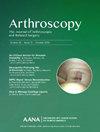Editorial Commentary: Combined Anterior Cruciate Ligament/Medial Collateral Ligament Injuries: Surgeons Should Have a Low Threshold to Operate on the Medial Collateral Ligament
IF 4.4
1区 医学
Q1 ORTHOPEDICS
Arthroscopy-The Journal of Arthroscopic and Related Surgery
Pub Date : 2025-05-01
DOI:10.1016/j.arthro.2024.07.004
引用次数: 0
Abstract
Combined anterior cruciate ligament/medial collateral ligament (ACL/MCL) injuries are relatively common, and multiple factors are involved in surgical decision-making, particularly when it comes to the MCL. Historically, most surgeons treated the MCL conservatively and performed staged MCL reconstruction after MCL reconstruction only if there was persistent medial instability. This was followed by a nonoperative approach for the MCL (when reconstructing the ACL) unless there was evidence of extreme (grade III or >1 cm) valgus instability, valgus malalignment, or mid-substance or tibial-sided injury, avulsion, or Stener lesion. However, the most recent research demonstrates that combined ACL/MCL injuries present a higher risk of ACL reconstruction failure and subsequent revision compared to ACL injuries alone. With growing biomechanical and clinical evidence, more surgeons are repairing or reconstructing the MCL in these combined injuries. Although there is no clear consensus, we recommend surgeons consider surgically treating the MCL to avoid not only excessive force on the ACL graft but also persistent valgus laxity, which can lead to ACL failure. For distal MCL avulsions, repairs have shown excellent midterm outcomes, especially if the tissue quality is pristine. If the tissue quality is not repairable, then we would advocate for repairing whatever tissue is repairable and augmenting with an MCL reconstruction. For mid-substance MCL injuries, if surgical intervention is required, we advocate for MCL reconstruction. For proximal tears, the same criteria used for distal tears apply with management based on tissue quality and joint stability after repair. The ACL is a secondary stabilizer to valgus loads, and MCL deficiency results in tremendous strain on ACL graft reconstructions. If the MCL is even mildly incompetent, we strongly advocate for treating the MCL surgically in this setting.
前交叉韧带/后交叉韧带联合损伤:外科医生应降低对 MCL 进行手术的阈值。
前交叉韧带/后交叉韧带联合损伤比较常见,手术决策涉及多种因素,尤其是涉及 MCL 时。一直以来,大多数外科医生对 MCL 采用保守治疗,只有在出现持续的内侧不稳定时,才会在 MCL 重建后进行分期 MCL 重建。随后,除非有证据表明存在极度(III 级或大于 1 厘米)的外翻不稳定性、外翻错位、中段或胫骨侧损伤、撕脱或 Stener 病变,否则 MCL 采用非手术治疗方法(重建 ACL 时)。然而,最新研究表明,与单纯前交叉韧带损伤相比,合并前交叉韧带/后交叉韧带损伤导致前交叉韧带重建失败和后续翻修的风险更高。随着生物力学和临床证据的不断增加,越来越多的外科医生开始修复或重建这些合并损伤的 MCL。虽然目前还没有明确的共识,但我们建议外科医生考虑通过手术治疗 MCL,这样不仅可以避免前交叉韧带移植物承受过大的力量,还可以避免持续的外翻松弛,因为外翻松弛会导致前交叉韧带损伤。对于 MCL 远端撕脱,修复后的中期疗效极佳,尤其是在组织质量完好的情况下。如果组织质量无法修复,那么我们会主张修复任何可以修复的组织,并用 MCL 重建进行增强。对于中期的 MCL 损伤,如果需要手术干预,我们主张进行 MCL 重建。对于近端撕裂,采用与远端撕裂相同的标准,根据组织质量和修复后的关节稳定性进行处理。前交叉韧带是外翻负荷的辅助稳定器,MCL缺损会对前交叉韧带移植重建造成巨大压力。如果 MCL 有轻微的功能障碍,我们强烈建议在这种情况下对 MCL 进行手术治疗。
本文章由计算机程序翻译,如有差异,请以英文原文为准。
求助全文
约1分钟内获得全文
求助全文
来源期刊
CiteScore
9.30
自引率
17.00%
发文量
555
审稿时长
58 days
期刊介绍:
Nowhere is minimally invasive surgery explained better than in Arthroscopy, the leading peer-reviewed journal in the field. Every issue enables you to put into perspective the usefulness of the various emerging arthroscopic techniques. The advantages and disadvantages of these methods -- along with their applications in various situations -- are discussed in relation to their efficiency, efficacy and cost benefit. As a special incentive, paid subscribers also receive access to the journal expanded website.

 求助内容:
求助内容: 应助结果提醒方式:
应助结果提醒方式:


